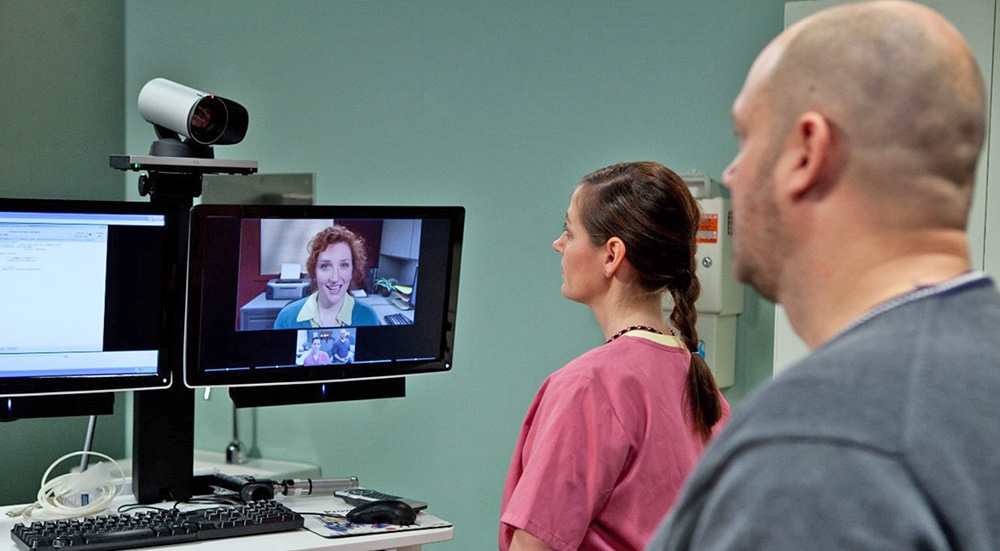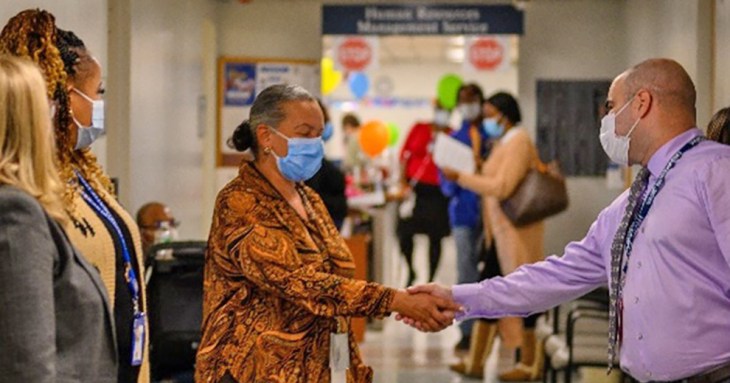Throughout the pandemic, Veteran care has remained VA’s primary responsibility and mission. Our COVID-19 Response Report and its annexes detail the lessons learned from VA’s efforts, challenges and successes in support of Veterans, their caregivers and the greater U.S. population.
The latest Annex D Interim Report covers the period from April 1, 2022, through July 31, 2022. During that time, the Omicron variant of the SARS-CoV-2 virus continued to spread throughout the United States. COVID-19 cases increased along with staffing shortages throughout the U.S. health care system. VA faced these challenges head-on, launching initiatives and deploying staff to meet the needs of Veterans and people across the country.
The photo above shows how Veterans benefitted from the expansion of telehealth during the pandemic.
Expanding COVID-19 initiatives
Virtual Test to Treat for early treatment of mild to moderate COVID-19 expanded during the Interim Reporting Period. Although Test to Treat had existed within VHA prior to the pandemic, the broad distribution of self-testing kits paved the way for a larger program to address COVID-19. VA became an industry leader in Test to Treat implementation during the pandemic.
The Annex D Interim Report also includes details on the expansion of innovations in 3D-printing, an initiative VA hopes to use as a means of preventing future supply chain challenges for certain medical supplies. By supporting innovative supply creation techniques, VA is using lessons learned from early in the pandemic to combat future disruptions.
VA also continued to grow its research into Long COVID, a condition in which individuals suffer from COVID-19 symptoms for four weeks or more after initial infection. VA estimates tens of thousands of Veterans have suffered from this condition since the pandemic began.
Reviewing health equity research
The Annex D Interim Report includes a literature review focused on Veteran-related health equity research on COVID-19 impacts. The review examines a single question across 12 studies: How did the impact of COVID-19 (specifically rates of infection, hospitalization and mortality) vary among Veterans of different racial and ethnic groups, rurality and sex/gender?
One of the findings revealed in examining these studies was that the impact of COVID-19 infection on specific racial and ethnic groups changed over the course of the pandemic. For instance, early on, urban Veterans suffered from higher rates of infection. Later in the pandemic, it was rural and highly rural Veterans who faced greater risk. Earlier in the pandemic, certain groups—including Black and American Indian and Alaska Native Veterans—experienced a higher risk of testing positive and dying of COVID-19. That disparity faded alongside the evolution of newly dominant variants.
VA also recognized the need for diagnostic medical technology that provides equally accurate results for patients of all races and ethnicities. Studies of pulse oximeters have shown they overestimate blood oxygen levels among non-Hispanic Black patients. The pandemic has brought this issue to light further given that pulse oximetry is used to guide COVID-19 treatment decisions.
Multiple research studies, including one focused on Veterans, found that non-Hispanic Black patients who use pulse oximeters are less likely to detect low blood oxygen levels, which may result in delayed or insufficient COVID-19 treatment for these patients.
Studies suggest this effect may also occur among other patients with darkly pigmented skin. VA is reaching out to manufacturers to push for solutions that pulse oximeters provide accurate results regardless of a patient’s skin pigmentation.
Looking to the future
Mindful of the changing nature of the pandemic, VA has continued to examine its challenges and build on its successes. COVID-19 presented our nation with an unprecedented set of difficulties and struggles, but through our commitment and dedication to Veteran care, VA employees have continued to triumph in the fight against this deadly and oft-changing virus.
The Annex D Interim Report offers a glimpse at the hard work being done to support Veterans through this difficult time. Its lessons will strengthen processes and decision-making strategies into the future.
Topics in this story
Link Disclaimer
This page includes links to other websites outside our control and jurisdiction. VA is not responsible for the privacy practices or the content of non-VA Web sites. We encourage you to review the privacy policy or terms and conditions of those sites to fully understand what information is collected and how it is used.
More Stories
Army Veteran Gregory Zielsdorf recounts his experience on the kidney donor list and through the transplant surgery.
Spinal cord stimulation implantation helps Veterans suffering from chronic pain improve their quality of life without narcotics.
After Addison’s Disease and lumbar spine surgery, nurse Veteran Gayle Smith re-learned how to ski. “You have more courage than you think.”








I need help’ no doctor will tell me the status of my health. No doctor will let me see a X-ray, ct, or mri. All my organs are critically damaged smashed to pieces and severed floating around. I have cancer, tumors, and disease all over. No large intestines (boot camp injury) and crippled feet non of this stuff is treated and no one will talk to me about any of it. I have suffered daily since 1993 April boot camp